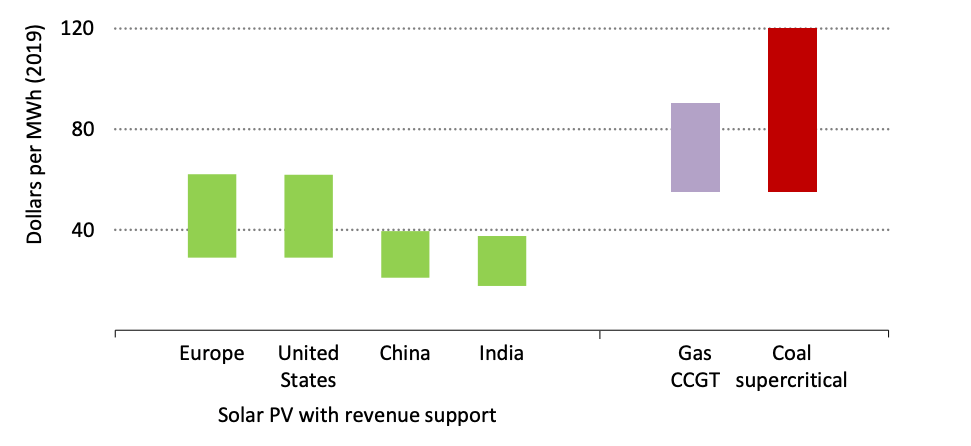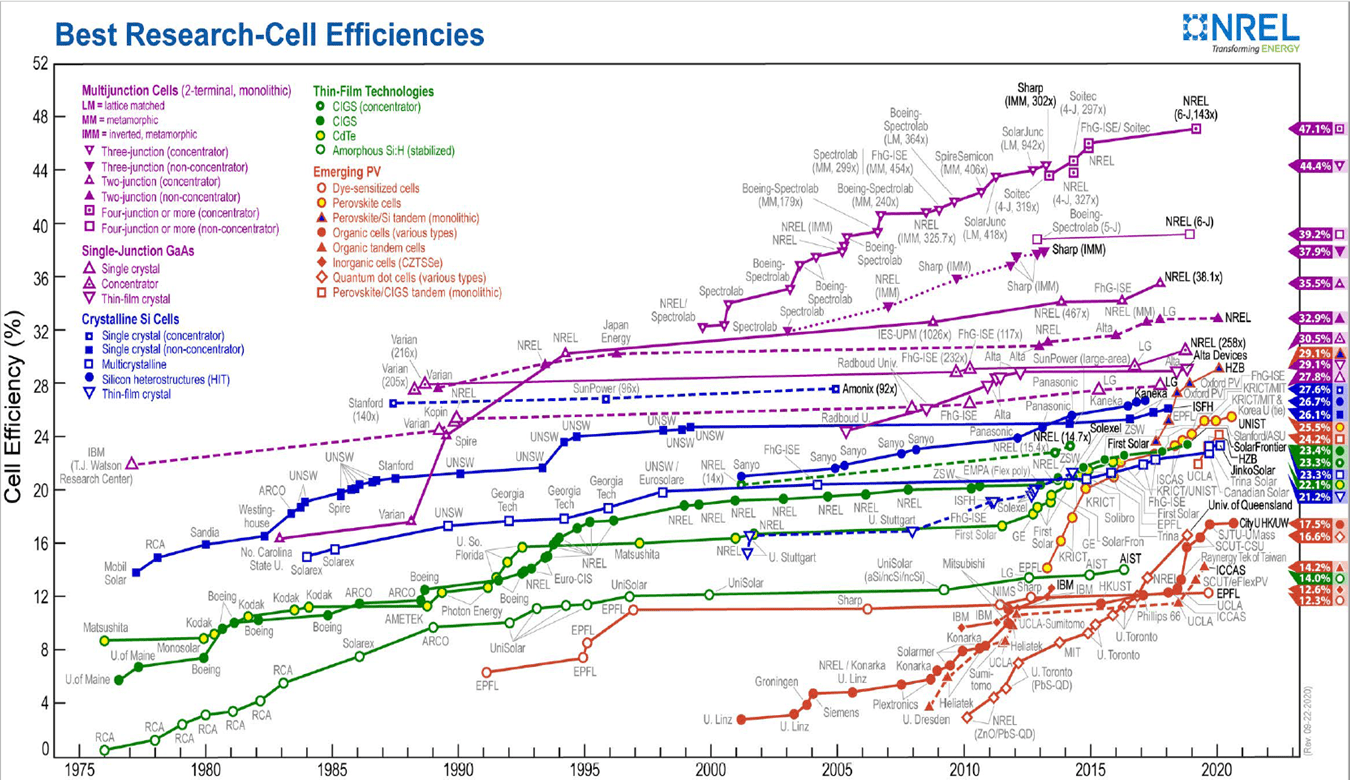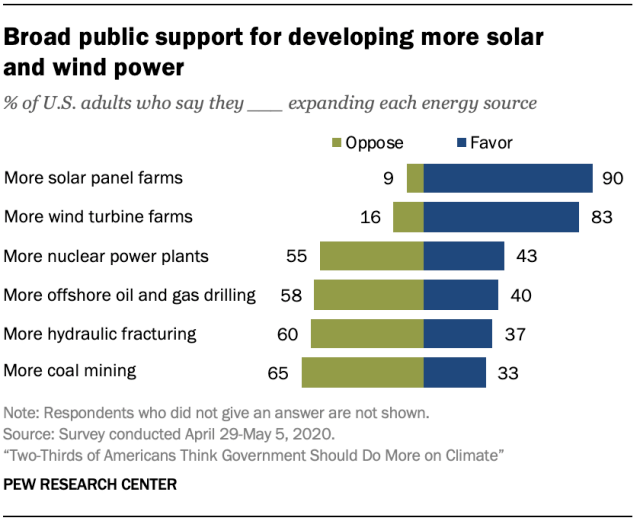Solar industry costs continue to plummet to new lows, and promising new technologies just now entering the industry are likely to cement that reality for a very long time.
Cheapest Form of Electricity in History
The International Energy Agency (IEA) recently released its annual World Energy Outlook, which made headlines for noting, for the first time, that solar power is now the cheapest source of electricity in history for most countries in the world.
“For projects with low-cost financing that tap high-quality resources, solar PV is now the cheapest source of electricity in history.”
-IEA 2020 World Energy Outlook
The IEA report lays out four different scenarios for how they see solar energy costs and production capacity changing through 2040. All of the pathways forecast a significant rise in renewables, owed primarily to rapidly falling costs.
The IEA’s main forecast anticipates that solar is actually some 20-50% cheaper today, across the world, than their own estimates from just last year. The drop is attributed almost entirely to the projection that the average cost of capital of solar projects is much lower than previously thought. In 2019, the IEA assumed that capital costs accounted for roughly 7-8% of total project costs. They’ve since revised that estimate to say that capital costs are closer to 4.4-5.5% for solar projects in the United States and even lower in Europe (2.6-5.0%). They credit the drop to pro-solar public policies that help to reduce project risk. Such policies exist in some form in over 130 countries.
According to the IEA, the average cost of solar energy generation over the lifetime of a solar energy generating site in the U.S. (the levelized cost of electricity or LCOE) is just $30-$60/MWh. By comparison, the cost for a new coal plant ranges from $55-$150/MWh and has hardly budged for more than a decade.
With solar project costs falling and supportive solar policies entrenching themselves around the world, the outlook for electricity generation capacity in the industry is sky high. The IEA now projects that solar output in the world could be up 43% compared to the organization’s 2018 outlook.
More Innovations Coming
As we’ve discussed before at Solar Tribune, the bending of the solar cost curve can be attributed to multiple factors, but the rapid gains in innovation and technological improvements in the industry are arguably the biggest driver. In addition to the above cited macro-level trends in the global cost of solar energy production, industry innovations like more efficient solar cells can help to drive costs down even further.
Silicon PV panels continue to be the dominate form of solar panel used throughout the industry. The highest performing silicon PV panels in the commercial space typically have energy efficiency rates between 20 and 25%, but many cheaper panels will be much lower. The physical placement of silicon PV panels is also notably limited given their relative clunky size.
Thin-film solar cells, specifically those made using perovskites, will lead the next generation of solar energy deployment.
Perovskites are a family of crystals named after Russian geologist, Leo Perovski, that are abundant in the Earth’s crust and not costly. Perovskite thin-film PV panels offer a number of important advantages over conventional silicon-based PV panels. They can absorb light from a wider range of wave-lengths, which allows them to produce more electricity from the same solar intensity than their silicon PV counterparts. Thin-film perovskite solar cells work better in the shade and on cloudy days than silicon-based ones, which only further underscores the broad efficiency gains they can bring to the industry.
These new age solar cells are also able to be produced in a much more efficient (ie, lower cost) manner. Thin-film perovskite-based solar cells can be printed using an inkjet printer and can be thinner than even an ordinary piece of paper.
The most common application of perovskite-based solar cells in the industry today are in the form of multijunction solar cells that compress both perovskite and silicon cells into one. Some of these multijunction solar cells boast efficiencies well above 30%, as noted in the below graphic from the National Renewable Energy Laboratory (NREL).
Solar cells comprised of perovskite alone remain in the early stages of development and are not quite ready for widespread commercialization and deployment. It is clear, however, that they represent the next frontier for the industry. Their relative affordability and flexible applications will only accelerate the already positive global outlook for the solar industry in coming decades.
Solar Momentum May Hinge on Election Outcome
The IEA report makes clear the positive impact that pro-solar policies can have on driving down solar industry costs. Even for an industry that is maturing and no longer so dependent on government support, the certainty that pro-solar initiatives bring helps to reduce project risk and adds stability to an industry that has seen its fair share of volatility in recent years.
We are now just days away from the 2020 general election, and former Vice President Joe Biden has a rather commanding lead in national polls and across a critical mass of battleground state polls. The outcome of the presidential race will be especially pivotal for the future of the solar industry. As we’ve highlighted before, Joe Biden is running on what is inarguably the most pro-solar campaign platform an American President has ever adopted. A Biden Administration would usher in a wave of pro-solar policy measures and ambitious national goals for ramping up solar capacity, the likes of which the nation has not seen before.
Even as the federal government has backed off in recent years from promoting growth in the solar industry, many state governments across the country picked up the slack. Pro-solar policies implemented in the past couple years in states like Virginia, Maryland, Illinois, South Carolina, and elsewhere have been crucial in drawing new solar users to the market in 2020. An important solar-related ballot measure will also be on the ballot this November in Nevada. The state’s “Question 6,” Renewable Energy Standards Initiative, will allow voters to support amending the state Constitution to require electric utilities to acquire 50% of their electricity from renewable resources by 2030.
It is sometimes easy to forget how overwhelming the support is, across the political spectrum, for expanding our renewable energy resources in the United States. A June poll conducted by the Pew Research Center noted that 90% of adults in the U.S. support the development of more solar panel farms.
Make no mistake about it, next week’s election will be especially consequential for addressing the harmful effects of climate change and for transitioning our energy infrastructure to one that is more focused on renewable sources. We encourage you to exercise your right to vote and make your pro-solar voice heard.
You can find out how to register to vote in your state here: https://vote.gov/
Cover Photo Source: U.S. Dept of Energy









